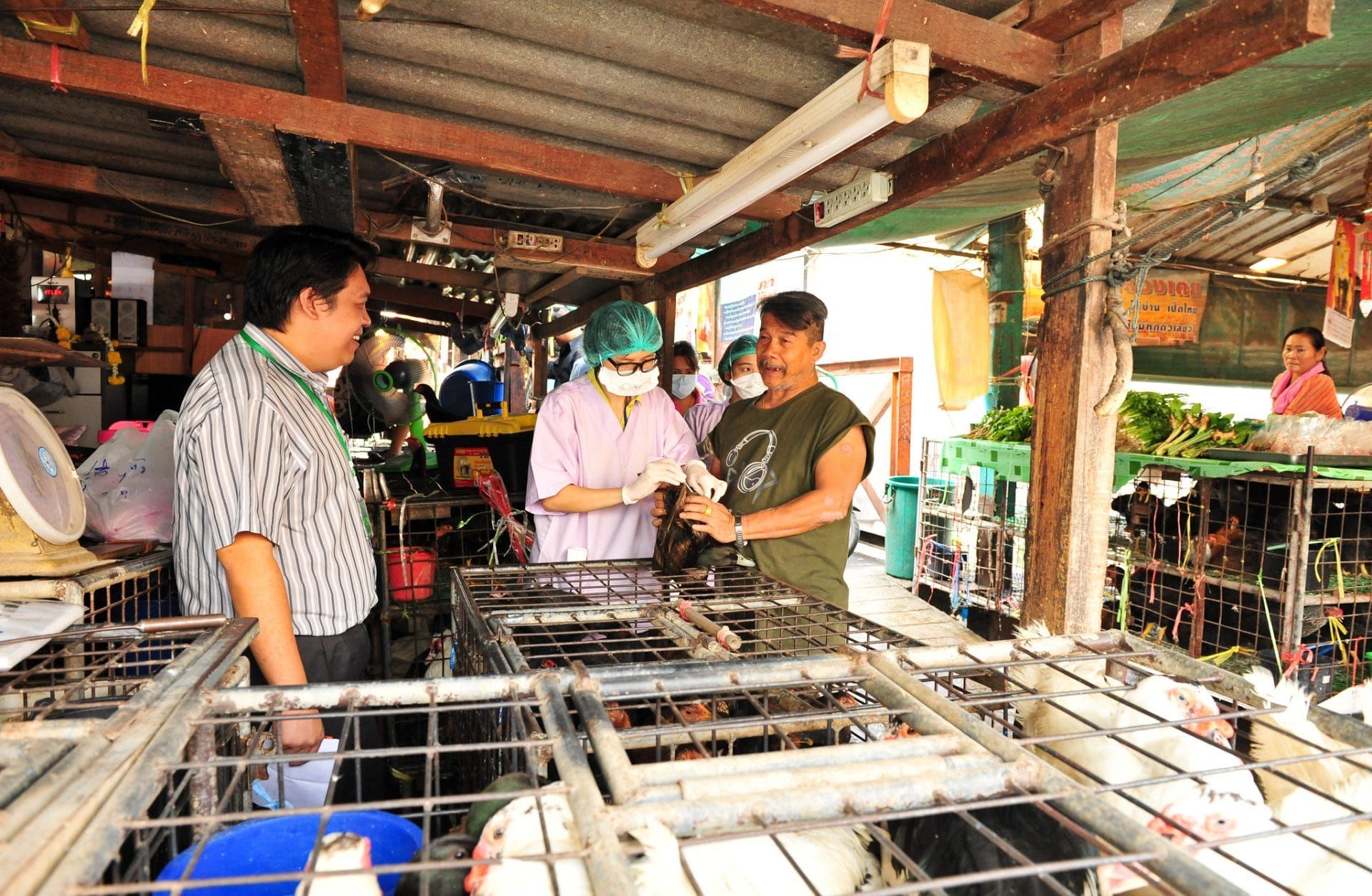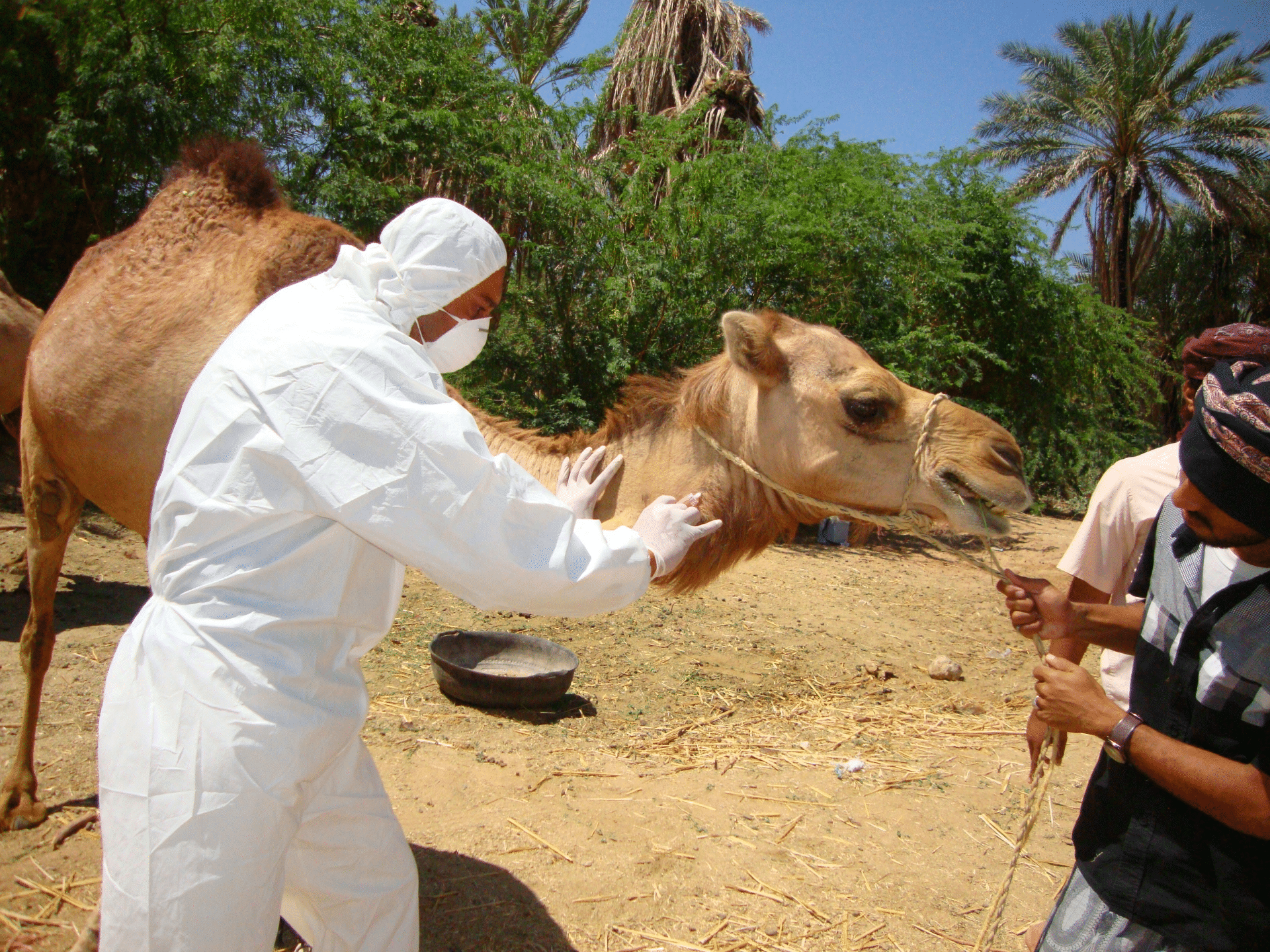COVID-19 lab-leak theory: Gain-of-function is a hot topic, but a bad explanation
By Nicholas G. Evans, Anna Muldoon | August 9, 2021
 The Wuhan Institute of Virology in Wuhan, China. Credit: Ureem2805 via Wikimedia Commons. CC BY-SA 4.0.
The Wuhan Institute of Virology in Wuhan, China. Credit: Ureem2805 via Wikimedia Commons. CC BY-SA 4.0.
For the second time in recent months, Sen. Rand Paul, a conservative Republican from Kentucky, sparred with Anthony Fauci, the director of the National Institute of Allergy and Infectious Disease, during a heated Congressional hearing on the coronavirus pandemic in July. By then, Fauci had already become a pandemic bogeyman for the American right, in part for undercutting former President Donald Trump’s rosy assessments of the COVID-19 situation and also for supposedly covering up alleged Chinese culpability in the pandemic’s origins. Pushing what has become a key assertion in the conservative case against Fauci, Paul accused the senior US infectious disease expert—along with government science funders—of financing so-called gain-of-function pathogen research in China, a type of experimentation in which researchers enhance the transmissibility, virulence, or host range of microbial agents. During the confrontation, the senator wove together the reputation of the research method with a controversial idea: that the pandemic could have been caused by a lab incident in Wuhan, China.
Fauci, for his part, told Paul, “officially,” that the senator didn’t know what he was talking about.
The idea that a lab accident could be responsible for the worst year-and-a-half the world has experienced in recent decades gained serious traction after prominent scientists rebuffed a World Health Organization investigation and subsequent report that found that a natural origin of the virus is the most likely explanation. This report led to a group of scientists calling for further review of lab research in Wuhan. But the so-called “lab escape theory” is really more a collection of theories that claim SARS-CoV-2, the virus that causes COVID-19, began its trajectory towards a global pandemic somewhere in a research facility. The typical culprit lab is the Wuhan Institute of Virology, China’s only biosafety level 4 laboratory. And an increasingly popular move in lab escape theories is to reference, as Paul did, so-called gain-of-function studies.
While the US government did in fact fund experiments that manipulated coronaviruses at the Wuhan Institute of Virology, officials like Fauci say those experiments don’t qualify as gain-of-function research, and, furthermore, that the manipulated pathogens involved didn’t spark the pandemic, a point that Paul acknowledged. “No one is alleging that those viruses caused the pandemic. What we’re alleging is that gain-of-function research was going on in that lab and [National Institutes of Health] funded it,” he said. Researchers in Wuhan were manipulating coronaviruses with US money, but not viruses that were known to affect people. Gain-of-function has nonetheless been incorporated into the COVID-19 origins debate.
It’s a linkage that has made a sound debate on both the potentially risky research method and on the origins of COVID-19 more difficult. As with any knot, to understand how gain-of-function and the lab escape theory have gotten so tangled up, it’s worth starting at the beginning.
The origins of gain-of-function. Some attempted definitions of gain-of-function are expansive, including claims that microbial agents in nature can “gain” a “function.” But in terms of US government policy and the debate over the lab escape theory, gain-of-function means something quite specific: an experiment conducted by researchers in which a microbial organism is engineered such that it gains a function that may enhance its ability to infect, cause disease, or kill its host. Of most concerning is gain-of-function research resulting in potential pandemic pathogens.

Gain-of-function involving the creation of potential pandemic pathogens emerged into public consciousness in 2011 with the controversy over two papers on influenza: one led by Ron Fouchier, of the Erasmus Medical Center in Rotterdam, the other by Yoshihiro Kawaoka of the University of Wisconsin-Madison and the University of Tokyo. These studies, funded by the US National Institutes of Health, examined the potential mutations that might allow H5N1, or avian influenza, to become a human-transmissible pandemic pathogen under the right circumstances by creating a virus with the right characteristics. In other words, the studies described the creation of exactly the kind of virus the public health community had been fearing for years. Their publication caused intense concern and a firestorm of criticism.
The debate in 2011 led to the creation of the “Framework for Guiding U.S. Department of Health and Human Services Funding Decisions about Research Proposals with the Potential for Generating Highly Pathogenic Avian Influenza H5N1 Viruses that are Transmissible among Mammals by Respiratory Droplets.”
The framework didn’t deal with all gain-of-function experiments, which are common. Scientists continue to alter the function of organisms in ways that arguably benefit humanity, such as enabling the study of coronaviruses through the development of a strain of Middle East respiratory virus (MERS) that can infect mice—animals typically used to study viral disease but that are resistant to the MERS coronavirus—allowing researchers to better study the human disease. Gain-of-function research involves many different types of experiments on microbes that pose a wide-range of risks—from entirely benign e. coli, for instance, to potential pandemic pathogens.
As the name suggests, the 2011 policy only covered influenza research. It wouldn’t stay that way.

In 2014, a series of biosafety scares—involving anthrax, avian influenza, and smallpox—led the US government to impose a moratorium on gain-of-function experiments dealing with research that could potentially enhance the virulence or transmissibility of influenza, or the SARS coronavirus responsible for the 2002-2003 outbreaks and the MERS coronavirus. The government put in place a deliberative process between the National Academies of Science, Engineering, and Medicine and the National Science Advisory Board for Biosecurity to develop a series of policy recommendations on assessing the risks and benefits of gain-of-function research in these viruses. The policy is known as the “HHS Framework for Guiding Funding Decisions about Proposed Research Involving Enhanced Potential Pandemic Pathogens.” Its implementation over that year led to the retraction of the gain-of-function funding moratorium in late 2017.
The framework has eight components that must be satisfied to justify US government funding of gain-of-function research. First, the project must be independently reviewed and determined to be scientifically sound. Second, the pathogen to be created must be reasonably judged to be a credible source of a potential future human pandemic. Third, an assessment of the overall potential risks and benefits associated with the project has to determine that the potential risks as compared to the potential benefits to society are justified. Fourth, there must be no feasible, equally efficacious alternative methods to address the same question in a manner that poses less risk than does the proposed approach.
The project must also satisfy three procedural steps and have a lab with an appropriate record of safety, a responsible communication plan for results, and a funding mechanism with appropriate oversight for safety and security. And finally, the project must be “ethically justified,” though what this means beyond the first seven steps is unclear.
What’s happened since? After the new review policy and the lifting of the moratorium, the gain-of-function world largely went quiet. It’s not clear if this was because there were no experiments of concern, or new developments. Certainly, there was some debate around the properties of the new policy. But it is possible, though not definitive, that the Trump administration did not care about gain-of-function, and equally possible that no one in an oversight role of the policy was particularly enthusiastic about making it an issue unless necessary during that time.
This changed in 2020. Officials on the federal biosecurity advisory board raised concerns about the transparency of the gain-of-function review process. The debate centered around concerns that the body that was set up to evaluate research did not release its findings publicly, the membership of that body was unknown, and the number of items it reviewed (and approved or denied) were likewise unknown. Proponents of increased transparency pointed to its value in building trust and in providing scholars who studied biosafety information on the decision-making process applied to the gain-of-function funding reviews.
Opponents of increased transparency noted that review bodies at that level of government are rarely transparent in the way proponents desired, and Christian Hassell at the Department of Health and Human Services has claimed that making this body open might deter individuals from serving on it. (Though that has never stopped, to our knowledge, anyone serving on the National Science Advisory Board for Biosecurity, the committee that recommended this new oversight body). Kenneth Bernard, who currently serves on the board, has noted that there were potential scientific and security risks associated with revealing information about the kinds of research being reviewed, including making the United States appear like it was running a covert biological weapons program. But at a time when Chinese officials are raising questions about what goes on in US government labs like Fort Detrick in Maryland, a lack of transparency has arguably made that problem worse in 2021—not better.
Then COVID-19 happened. And like much else in biosecurity, experts re-focused from the gain-of-function debates to the pandemic. Few continued to debate the gain-of-function reviews and the research has remained largely undiscussed since, with the exception of the theory that SARS-CoV-2 is, itself, a product of a gain-of-function experiment.
What do COVID-19 and gain-of-function have to do with one another? As assertions that COVID-19 must have leaked from the Wuhan Virological Institute have gained support from the public and some members of Congress, the long-standing debates about gain-of-function research have been drawn into the conversation. From Paul’s assertion that the National Institutes of Health funded gain-of-function research at the Wuhan lab to debates about whether a location on the SARS-CoV-2 virus—called the furin cleavage site—shows signs of genetic engineering, conversations about the lab escape theory and gain-of-function have become utterly intertwined.
But this connection is, frankly, spurious. There is no reason a hypothetical lab leak would have to be the result of a gain-of-function experiment. Many proponents of the theory simply assume enhancement rather than show any evidence of it. They forget that laboratory safety doesn’t need gain-of-function experiments to be important.
This conflation of all laboratory research with gain-of-function research muddies the waters around the origins of COVID-19. It also leads to debates that misunderstand the risks of life sciences research, and the risks that bad-faith arguments like Paul’s pose in the context of this pandemic. Any discussion of the lab escape theory should in fact be divided into two separate issues: first, whether the virus emerged from a laboratory; second, what kind of experiment it could be.
It seems unlikely on its face—though, of course, not strictly impossible—that a gain-of-function experiment is to blame for the COVID-19 pandemic. There have been a number of papers published that have gone into considerable details to show that the possibility of engineering is very low. A recent review of these arguments by University of Sydney evolutionary biologist Edward Holmes and colleagues includes a positive argument for zoonotic (natural) origins of the SARS-CoV-2 virus and an argument against gain-of-function having played a role. Holmes’ report notes that the basic building blocks of SARS-CoV-2 aren’t consistent with the limited gain-of-function research conducted at the Wuhan Institute of Virology, meaning that even the existence of that research doesn’t connect to COVID-19. Things are rarely absolutely certain in science, especially in the life sciences, but it seems that gain-of-function research is not to blame for the pandemic.
For researchers to have engaged in a gain-of-function experiment at the Wuhan Institute of Virology that led to a lab escape, one would have to accept that a cover-up had occurred—the plentiful details that Holmes and colleagues, among others, have described about Wuhan Institute of Virology would have to disguise a secret, highly technical experiment that was important enough to spend resources on but not so important that the scientists left any record of it and never sought to publish any of their results.
Nonetheless, the gain-of-function theory seems to have become the darling of some scientists and many political commentators in recent weeks. Despite ongoing scientific uncertainty and debate, some authors have already gone so far as to apportion blame to scientific communities for a potential lab leak. At times, some people simply want or need COVID-19 to be anything but natural, because otherwise society would have to accept that occasionally nature is downright nasty. But wanting to believe natural pathogens are not so deadly or wanting someone to blame for this maddening 18 months is no reason to assume only humans could have created this virus.
While the world has not yet seen a pandemic caused by an altered virus, there has been a human pandemic and an animal outbreak likely caused by lab escape of natural viruses. It is likely the 1977 flu pandemic escaped from a lab, possibly during vaccine development. A 2007 foot-and-mouth disease outbreak was caused by a faulty pipe at the Pirbright Institute, a disease research center in England, leading to 278 infected cattle on 8 farms. In the first case, the genetics of the flu strain showed that it was most closely related to strains circulating in 1949-50, rather than contemporary strains. In the case of foot-and-mouth disease, genetic analysis also quickly identified the Pirbright Institute as the likely source of the outbreak, even as investigations and response continued. The two cases show that natural viruses held in laboratories for study, reference samples, and basic disease research can pose risks worth discussing. Since the Wuhan Institute of Virology was a centralized collection point for coronavirus samples for study, in many ways this type of lab escape would be more likely than a gain-of-function experiment, though still unproven.
Two important things arise from this. The first is that even if there were definitive evidence of a lab escape of some kind, all other things being equal it seems much less likely that this lab escape was a result of gain-of-function experiments, and more likely that it was the result of normal laboratory functions in collecting pathogens form animal hosts for analysis. This is a primary function of the Wuhan Institute of Virology; it is a laboratory built close to a known reservoir for coronaviruses and other emerging infectious disease. One can only imagine how the risk profile would increase if researchers were always mailing those samples thousands—or tens of thousands—of miles further for analysis. It makes sense to have a lab in Wuhan, but it is not a riskless activity.
A second question that we have both asked about the lab escape theory is “so what”? A lab escape would be bad. But gain-of-function experiments were already a concern—this pandemic doesn’t and won’t change that. Pandemics were already a concern—a lab escape wouldn’t and won’t change that. And the oversight of both of these health security concerns remains fragmented, and historically so.
COVID-19 is scary. Gain-of-function experiments can be scary. But not all scary things are related. It is unlikely that COVID-19 is the result of a lab escape. But even if was, there is little reason to believe that this lab escape was the result of a gain-of-function experiment. There’s nothing in particular about gain-of-function experiments that make them more likely to cause a lab escape than any other kind of experiments on pathogens.
In the end, scientific and policy communities have a strong interest in continuing calm, evidence-based conversations about both the origins of COVID-19 and gain-of-function experiments. Understanding the origins of COVID-19 will help us detect and prepare for future pandemics. Agreeing to international guidelines around gain-of-function would encourage safe, responsible, and publicly acceptable research. However, in order to continue either conversation, researchers, officials, and others must disentangle the two from each other and from other forms of laboratory research. Conflating the two helps no one, and arguably makes fixing either more difficult.
Together, we make the world safer.
The Bulletin elevates expert voices above the noise. But as an independent nonprofit organization, our operations depend on the support of readers like you. Help us continue to deliver quality journalism that holds leaders accountable. Your support of our work at any level is important. In return, we promise our coverage will be understandable, influential, vigilant, solution-oriented, and fair-minded. Together we can make a difference.
Keywords: Anthony Fauci, Coronavirus, Rand Paul, Wuhan Institute of Virology, gain-of-function research, lab leak
Topics: Disruptive Technologies
















The first article I read about core samples taken from (melting) permafrost involved samples from Northern Europe. Collaborating scientists had pulled up nematodes which were able to swim when thawed from about 30,000 years ago. Next came the images of a 40,000 year old lion preserved in Siberian ice, and a flowering plant developed from fruit that was about 23,000 years old. None of it is ever virus-free. This collaborative work is world-wide, shared among scientists interested in origins and evolutionary development. Wuhan is only one location. No one is manipulating this stuff. All it takes is for someone to… Read more »
Research on viruses is very important to do, and for understanding. Publishing those results is key to sharing knowledge and of course, for a scientist to get his or her name out there. The problem is the publications being read by those who have NO IDEA of the science. Then these ‘writers’ spin their own version of what is going on, and then blog it, post it, or submit their uninformed critique to a major news outlet. This is how the misinformation or intentional attack on science research gets the public all worried and more ‘tweets and Instagrams go out… Read more »
Wuhan close to the source of Coroviruses? Try 1000 miles
It is correct that we mustn’t throw out the research baby with the lab leak bathwater. And also true that there are often public over-reactions to disasters which prevent a dispassionate cost-benefit analysis from being applied. An example being nuclear power.
However, the circumstantial evidence of it being a lab leak are pretty overwhelming.
Has gain-of-function research produced anything of value equal to the risk it poses? According to a 2005 issue of Science Magazine (Has Biodfense Gone Overboard?,) scientists warned that a post-9/11 surge in funding for biodefense research came at the expense of funding for basic research. “While budgets have skyrocketed for exotic agents such as plague, anthrax, and tularemia–each of them negligible as human health threats–research on widespread and perhaps mundane pathogens is falling by the wayside…”
How lazy is that to believe it doesn’t matter if it was a lab leak or gain of function research. It’s incredibly important to get to the root cause of an issue, only then can you find the best course of action. The mass hysteria we have now because of a “coincidental” leak or natural pangolin transmission is what’s scary. The pandemic comes from those with all of the information from the beginning and if there are coverups or collusion the public deserves to know.
To what end? So that we can then attempt to blow up Wuhan, or the Siberian or Alaskan laboratories? What about the British and German researchers bringing up materials that possibly should have been left alone? The problem with viruses is that they were never “alive” to begin with. They only leave dormancy temporarily, whenever the right conditions arise. They are chemical by nature and respond to heat and electricity. So when they thaw out, they move. We have no immunity to 30,000 year old viral matter. And there are plenty in the permafrost. Now imagine the number of thawing… Read more »
@ Kim Thompson: “To what end?” So we should ignore the actual cause of a disease that has killed millions globally? SARS-CoV-2 has induced at least two forms of mass hysteria: [i] among those who fear that they will contract the disease; and [ii] among the smaller group of people who wish to have gain-of-function research performed that risks human pandemic and are frightened that a concrete public tie between SARS-CoV-2 and gain of function research would almost certainly result in a moratorium on such research. It’s striking that the major opposition to investigating the laboratory origin theory has come… Read more »
In a field loaded with opinions and politics it is sad to see this article published with obviously inadequate understanding of basic biology and virology to back up their opinions. The Wuhan Lab with Dr Zheng Li-Shi as author published in 2017 in PLOS Pathogens PLOS Pathogens | https://doi.org/10.1371/journal.ppat.1006698 a description of their research with coronaviruses, in which they create artificial, chimeric viruses which gained the function of being able to infect mammalian cells, namely VERO-E6 cells, which are monkey cells.The study was partially funded by the National Institutes of Health (NIAID R01AI110964), the USAID Emerging Pandemic Threats (EPT) PREDICT… Read more »
Dr. Evans and Ms. Muldoon: Hoping you can revise this statement, which undermines the credibility of this article: “This is a primary function of the Wuhan Institute of Virology; it is a laboratory built close to a known reservoir for coronaviruses and other emerging infectious disease. One can only imagine how the risk profile would increase if researchers were always mailing those samples thousands—or tens of thousands—of miles further for analysis. It makes sense to have a lab in Wuhan, but it is not a riskless activity.” As pointed out by @ayjchan, the WIV in fact is >1000 miles by… Read more »
There’s nit picking about how to define gain of function but the WIV did seem to be modifying bat coronaviruses to make them infectious to humanized mice cells which seems like a gain of function to me and also the kind of thing that could have resulted in covid.
You mention the “HHS Framework for Guiding Funding Decisions about Proposed Research Involving Enhanced Potential Pandemic Pathogens” https://www.phe.gov/s3/dualuse/Documents/P3CO.pdf, and ‘eight components’ of handling enhanced PPPs. That Framework defines enhanced PPPs as, the “enhancement of the transmissibility and/or virulence of a pathogen”. The ‘exception’ being, “Enhanced PPPs do not include naturally occurring pathogens that are circulating in or have been recovered from nature, regardless of their pandemic potential.” According to this “exception”, if Covid-19 naturally occurred and had been circulating in nature, then no enhanced PPP, and HHS funding is OK, if I am reading this ”exception” correctly. Setting aside the Rand Paul and Fauci debate on GOF… Read more »
The content of this article — incidentally, written by an Assistant Professor of Philosophy and an author of books on conspiracy theory (neither of whom would appear to know much about genetics, or, for that matter, covert biological research) — does not qualify as science.